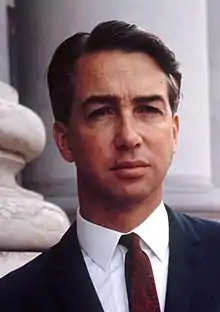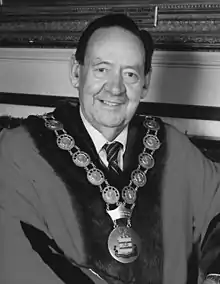1973 South Australian state election
State elections were held in South Australia on 10 March 1973. All 47 seats in the South Australian House of Assembly were up for election. The incumbent Australian Labor Party led by Premier of South Australia Don Dunstan won a second term in government, defeating the Liberal and Country League led by Leader of the Opposition Bruce Eastick.
| |||||||||||||||||||||||||||||||
All 47 seats in the South Australian House of Assembly 24 seats were needed for a majority 10 (of the 20) seats of the South Australian Legislative Council | |||||||||||||||||||||||||||||||
|---|---|---|---|---|---|---|---|---|---|---|---|---|---|---|---|---|---|---|---|---|---|---|---|---|---|---|---|---|---|---|---|
| |||||||||||||||||||||||||||||||
| |||||||||||||||||||||||||||||||
Background
Parliamentary elections for both houses of the Parliament of South Australia were held in South Australia in 1973, which saw Don Dunstan and the Australian Labor Party win a second successive term, against the Liberal and Country League (LCL) led by Bruce Eastick.
It was only the second time that a Labor government in South Australia had been re-elected for a second term, the first being the early Thomas Price Labor government. It would be the first five-year-incumbent Labor government however.
Moderate Liberal Movement forces within the LCL broke away to form its own party led by Steele Hall after the election in 1973. The LCL became the South Australian Division of the Liberal Party of Australia a year after the election.
The Country Party also won a seat for the first time in Flinders, and finished second after preferences with no Labor candidate in five LCL seats − Rocky River, Mallee, Alexandra, Goyder and Victoria.
A 1973 Semaphore by-election and a 1974 Goyder by-election were triggered. Labor and the Liberal Movement easily retained their respective seats.
Key dates
- Issue of writ: 20 February 1973
- Close of nominations: 27 February 1973
- Polling day: 10 March 1973
- Return of writ: On or before 10 April 1973
Results
House of Assembly
|
South Australian state election, 10 March 1973[1] | ||||||
|---|---|---|---|---|---|---|
| Enrolled voters | 696,290 | |||||
| Votes cast | 655,937 | Turnout | 94.20% | -0.83% | ||
| Informal votes | 26,794 | Informal | 4.08% | +2.02% | ||
| Summary of votes by party | ||||||
| Party | Primary votes | % | Swing | Seats | Change | |
| Labor | 324,135 | 51.52% | –0.12% | 26 | - 1 | |
| Liberal and Country | 250,312 | 39.79% | –3.97% | 20 | ± 0 | |
| Country | 24,810 | 3.94% | +2.05% | 1 | + 1 | |
| Independent | 27,178 | 4.32% | +2.86% | 0 | ± 0 | |
| Other | 2,708 | 0.43% | * | 0 | ± 0 | |
| Total | 629,143 | 47 | ||||
| Two-party-preferred | ||||||
| Labor | 54.50% | +1.20% | ||||
| Liberal and Country | 45.50% | –1.20% | ||||
Legislative Council
|
South Australian state election, 10 March, 1973[2] | ||||||
|---|---|---|---|---|---|---|
| Enrolled voters | 383,758 | |||||
| Votes cast | 357,971 | Turnout | 93.3 | –1.9 | ||
| Informal votes | 27,140 | Informal | 7.6 | +1.7 | ||
| Summary of votes by party | ||||||
| Party | Primary votes | % | Swing | Seats won |
Seats held | |
| Labor | 174,082 | 52.6 | –5.3 | 4 | 6 | |
| Liberal and Country | 152,921 | 46.2 | +4.2 | 6 | 14 | |
| Australia | 2,618 | 0.8 | +0.8 | 0 | 0 | |
| Independent | 1,210 | 0.4 | +0.4 | 0 | 0 | |
| Total | 330,831 | 10 | 20 | |||
Post-election pendulum
| Labor seats (26) | |||
| Marginal | |||
| Gilles | Jack Slater | ALP | 5.8% |
| Fairly safe | |||
| Millicent | Des Corcoran | ALP | 6.5% |
| Coles | Len King | ALP | 9.2% |
| Peake | Don Simmons | ALP | 9.6% |
| Norwood | Don Dunstan | ALP | 9.6% |
| Safe | |||
| Henley Beach | Glen Broomhill | ALP | 10.2% |
| Mitchell | Ron Payne | ALP | 11.0% |
| Unley | Gil Langley | ALP | 11.6% |
| Brighton | Hugh Hudson | ALP | 12.0% |
| Mount Gambier | Allan Burdon | ALP | 14.0% |
| Mawson | Don Hopgood | ALP | 14.1% |
| Tea Tree Gully | Molly Byrne | ALP | 14.1% |
| Ascot Park | Geoff Virgo | ALP | 14.7% |
| Playford | Terry McRae | ALP | 14.8% |
| Adelaide | Jack Wright | ALP | 16.7% |
| Elizabeth | Peter Duncan | ALP | 19.6% |
| Florey | Charles Wells | ALP | 20.4% |
| Albert Park | Charles Harrison | ALP | 21.7% |
| Price | John Ryan | ALP | 22.5% |
| Pirie | Dave McKee | ALP | 23.9% v IND |
| Whyalla | Max Brown | ALP | 24.7% |
| Semaphore | Reg Hurst | ALP | 26.0% |
| Ross Smith | Jack Jennings | ALP | 30.3% v IND |
| Stuart | Gavin Keneally | ALP | 31.2% v IND |
| Spence | Ernie Crimes | ALP | 31.9% v IND |
| Salisbury | Reg Groth | ALP | 34.0% v IND |
| LCL seats (20) | |||
| Marginal | |||
| Rocky River | Howard Venning | LCL | 0.2% v NAT |
| Hanson | Heini Becker | LCL | 2.4% |
| Glenelg | John Mathwin | LCL | 2.7% |
| Mallee | Bill Nankivell | LCL | 3.2% v NAT |
| Chaffey | Peter Arnold | LCL | 3.5% |
| Torrens | John Coumbe | LCL | 5.2% |
| Fairly safe | |||
| Murray | Ivon Wardle | LCL | 7.3% |
| Alexandra | Ted Chapman | LCL | 8.2% v NAT |
| Fisher | Stan Evans | LCL | 9.4% |
| Safe | |||
| Goyder | David Boundy | LCL | 10.3% v NAT |
| Frome | Ernest Allen | LCL | 10.9% |
| Light | Bruce Eastick | LCL | 13.6% |
| Gouger | Keith Russack | LCL | 13.6% |
| Victoria | Allan Rodda | LCL | 14.1% v NAT |
| Mitcham | Robin Millhouse | LCL | 15.7% |
| Bragg | David Tonkin | LCL | 16.4% |
| Davenport | Dean Brown | LCL | 18.2% |
| Kavel | Roger Goldsworthy | LCL | 20.0% |
| Eyre | Graham Gunn | LCL | 22.6% |
| Heysen | William McAnaney | LCL | 23.0% |
| Crossbench seats (1) | |||
| Flinders | Peter Blacker | CP | 4.9% v LCL |
See also
References
- History of South Australian elections 1857–2006, volume 1: House of Assembly, by Dean Jaensch, published by History Trust of SA and State Electoral Office of SA.
- History of South Australian elections 1857–2006, volume 2: Legislative Council Archived 22 December 2017 at the Wayback Machine, by Dean Jaensch, published by History Trust of SA and State Electoral Office of SA.
- Historical lower house results, ABC
- Historical upper house results, ABC
- State and federal election results Archived 18 January 2015 at the Wayback Machine in Australia since 1890, University of WA
- Specific
- "Details of SA 1973 Election". Australian Politics and Elections Database.
- "History of South Australian elections 1857–2006, volume 2 Legislative Council". ECSA. Archived from the original on 8 March 2016. Retrieved 22 May 2016.

